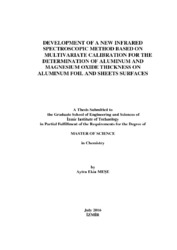Please use this identifier to cite or link to this item:
https://hdl.handle.net/11147/4869Full metadata record
| DC Field | Value | Language |
|---|---|---|
| dc.contributor.advisor | Özdemir, Durmuş | en_US |
| dc.contributor.author | Meşe, Ayten Ekin | - |
| dc.date.accessioned | 2017-02-20T13:21:15Z | - |
| dc.date.available | 2017-02-20T13:21:15Z | - |
| dc.date.issued | 2016-07 | - |
| dc.identifier.citation | Meşe, A. E. (2016). Development of a new infrared spectroscopic method based on multivariate calibration for the determination of aluminum and magnesium oxid thickness on aluminum foil and sheets surfaces. Unpublished master's thesis, İzmir Institute of Technology, İzmir, Turkey | en_US |
| dc.identifier.uri | http://hdl.handle.net/11147/4869 | - |
| dc.description | Thesis (Master)--İzmir Institute of Technology, Chemistry, İzmir, 2016 | en_US |
| dc.description | Full text release delayed at author's request until 2019.08.22 | en_US |
| dc.description | Includes bibliographical references (leaves: 118-120) | en_US |
| dc.description | Text in English; Abstract: Turkish and English | en_US |
| dc.description | xvii, 120 leaves | en_US |
| dc.description.abstract | Surface oxidation is a general problem for certain industrial applications such as coating and painting of the finished rolled products. A detailed understanding for the oxide growth mechanism as well as the development of a simple analytical method to measure this oxide thickness is very important in aluminum rolling industry and this study aims to develop a spectroscopic method to determine the oxide thicknesses on the surface of the aluminum by using multivariate calibration and infrared spectroscopy. Two main series of different aluminum alloys (3005 and 3003BZ) were selected in this study to develop a proposed methodology which is based on the combination of Fourier Transform Infrared Spectroscopy (FTIR) with Grazing Angle ATR accessory and chemometrics multivariate calibration techniques. In order to obtain oxide thickness values, X-ray Photoelectron Spectroscopy (XPS) was used and aluminum oxide (Al2O3) and magnesium oxide (MgO) thicknesses determinations were carried out by two different multivariate calibration models which are Genetic Inverse Least Squares (GILS) and Genetic Partial Least Squares (GPLS). These models were able to predict Al2O3 and MgO thicknesses using FTIR that is faster, easier and cheaper to operate as well as from XPS. The correlation coefficients of XPS reference oxide thickness values versus FTIR-GATR based GILS and GPLS predicted values were better than 0.919 in range of 0 to 25 nanometers for Al2O3 and 0 to 35 nm for MgO. These results suggest that grazing angle FTIR-ATR spectroscopy may offer a simple and nondestructive alternative for quick determination of oxide layer thickness. | en_US |
| dc.description.abstract | Alüminyum alaşımları doğal bir oksit tabakasını yüzeyinde barındırır. Ancak kimi yüksek sıcaklık ısıl işlemleri veya tavlama işlemleri sonrasında da atmosferik oksijen ve/veya nemi yardımıyla malzeme yüzeyinde daha düzensiz kristalografik yapılarda oksit tabakası meydana gelir. Bir alüminyum alaşımının yüzeyinde oluşan nanometre mertebesindeki oksit kalınlığının ölçümü için uygulanabilecek yöntemler, uzun numune hazırlama işlemleri ve X-ışınları fotoelektron spektroskopisi (XPS) gibi gelişmiş fakat pahalı ve zaman alıcı teknikler gerektirmektedir. Bu çalışmada, kızılötesi ve çok değişkenli kalibrasyon metotları kullanılarak alüminyum üzerindeki Al2O3 ve MgO kalınlıklarının ölçülebilmesi amaçlanmıştır. Bu çalışma kapsamında iki farklı alüminyum levha (3005 ve 3003BZ) örneği seçilmiş olup, Grazing Angle ATR aksesuarlı Fourier dönüşümlü kızılötesi spekstroskopisi ile ölçümleri alınmıştır. Dört farklı süre ve beş farklı tavlama sıcaklığı kullanılarak hazırlanan levha ve folyoların spektrumları alındıktan sonra, referans Al2O3 ve MgO kalınlıkları XPS ile ölçülmüştür. Elde edilen verilere kemometrik çok değişkenli kalibrasyon yaklaşımı uygulanmış ve modelleme çalışmalarında Genetik En Küçük Ters Kareler (GILS) ve Genetik Kısmi En Küçük Kareler (GPLS) metotları kullanılmıştır. Elde edilen modelleme sonuçları, hem Al2O3 hem de MgO kalınlığının belirlenmesinde başarıya ulaşılmış olup, XPS metodundan daha hızlı, basit ve kısa zamanda ölçüm yapma olasılığı sağlamıştır. GILS ve GPLS metotları ile elde edilen modellerin korelasyon katsayılarına bakıldığında, 0-25 nm arasında değişen Al2O3 kalınlığı ve 0-35 nm arasında değişen MgO kalınlıklarında, her iki model için de 0.919’den daha iyi modeller elde edilmiştir. Çalışma sonucunda FTIR-GATR spektroskopisinin oksit kalınlığını belirlemede hızlı ve tahribatsız ölçümler yapabildiği sonucuna ulaşılmıştır. | en_US |
| dc.language.iso | en | en_US |
| dc.publisher | İzmir Institute of Technology | - |
| dc.publisher | Izmir Institute of Technology | en_US |
| dc.rights | info:eu-repo/semantics/openAccess | en_US |
| dc.subject | Surface oxidation | en_US |
| dc.subject | Infrared spectroscopy | en_US |
| dc.subject | Aluminum alloys | en_US |
| dc.subject | Magnesium oxide | en_US |
| dc.subject | X-ray photoelectron spectroscopy | en_US |
| dc.subject | Aluminum foil | en_US |
| dc.title | Development of a new infrared spectroscopic method based on multivariate calibration for the determination of aluminum and magnesium oxid thickness on aluminum foil and sheets surfaces | en_US |
| dc.title.alternative | Alüminyum levha ve folyoların yüzeylerinde oluşan alüminyum ve magnezyum oksit kalınlıklarının belirlenmesi için çok değişkenli kalibrasyona dayalı yen bir kızıl ötesi spektroskopik metot geliştirilmesi | en_US |
| dc.type | Master Thesis | en_US |
| dc.institutionauthor | Meşe, Ayten Ekin | - |
| dc.department | Thesis (Master)--İzmir Institute of Technology, Chemistry | en_US |
| dc.request.email | aytenekinmese@gmail.com | - |
| dc.request.fullname | Ayten Ekin Meşe | - |
| dc.relation.publicationcategory | Tez | en_US |
| item.languageiso639-1 | en | - |
| item.fulltext | With Fulltext | - |
| item.openairecristype | http://purl.org/coar/resource_type/c_18cf | - |
| item.openairetype | Master Thesis | - |
| item.grantfulltext | open | - |
| item.cerifentitytype | Publications | - |
| Appears in Collections: | Master Degree / Yüksek Lisans Tezleri | |
Files in This Item:
| File | Description | Size | Format | |
|---|---|---|---|---|
| T001527.pdf | MasterThesis | 40.9 MB | Adobe PDF |  View/Open |
CORE Recommender
Page view(s)
200
checked on Jul 22, 2024
Download(s)
68
checked on Jul 22, 2024
Google ScholarTM
Check
Items in GCRIS Repository are protected by copyright, with all rights reserved, unless otherwise indicated.